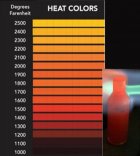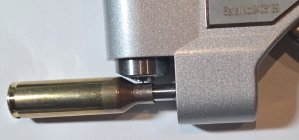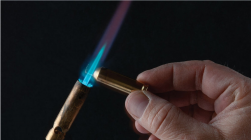Hello, riflemonkey here... Just purchased a AGS gas flame annealing unit and I have played with it some. I am annealing norma, hornady, and lapua brass 6.5 prc cases, once shot at this point. I am waiting on some Tempilaq 750 degrees for my testing... Have looked at red glow in dark but seems a little imprecise...
My question is what is your gas flame annealing process ?
For example, I plan the following process:
1 - Aim the flame tip near the bottom of the neck where it meets the shoulder for the case rotation on the machine,
2 - Test with Tempilaq 750 degrees F with a short vertical line to show that the neck reaches 750 degrees F but at 1/2" to 3/4" below the neck the body does not.
3 - Let the cases fall from the machine and air cool slowly
4 - Done. Clean and resize, etc.
I am looking at, rougly, a red neck inside near the top of the neck as the case drops and I have shot with an IR gun and I am seeing 500-600 inside the case neck before it drops. What are your temperature parameters? Also, do you air cool slowly or water cool? Do you check with Tempilaq?
I am really interested in gas flame annealing processes here, I do not have the budget for the induction machines...
Thanks for comments,
-riflemonkey
My question is what is your gas flame annealing process ?
For example, I plan the following process:
1 - Aim the flame tip near the bottom of the neck where it meets the shoulder for the case rotation on the machine,
2 - Test with Tempilaq 750 degrees F with a short vertical line to show that the neck reaches 750 degrees F but at 1/2" to 3/4" below the neck the body does not.
3 - Let the cases fall from the machine and air cool slowly
4 - Done. Clean and resize, etc.
I am looking at, rougly, a red neck inside near the top of the neck as the case drops and I have shot with an IR gun and I am seeing 500-600 inside the case neck before it drops. What are your temperature parameters? Also, do you air cool slowly or water cool? Do you check with Tempilaq?
I am really interested in gas flame annealing processes here, I do not have the budget for the induction machines...
Thanks for comments,
-riflemonkey















